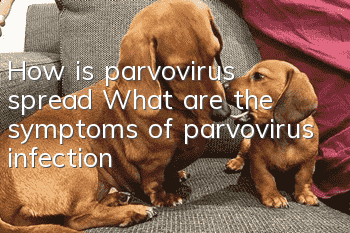How is parvovirus spread? What are the symptoms of parvovirus infection?

Canine parvovirus (CPV) disease is currently the most common infectious disease in dogs.
Parvovirus is a highly contagious disease characterized by diarrhea, often bloody diarrhea.
Currently, the spread of this disease is controlled mainly through vaccination, but some dogs will die from parvovirus despite being vaccinated. There are many viruses we don’t know about and better ways to control the disease, which require constant learning of new information. Vaccination is the most effective way to control the disease, and doctors hope to learn more about it to help prevent and reduce its spread.
How is parvovirus spread?
Contact with feces containing the virus is the main way to spread parvovirus. The virus lives on inanimate carriers, such as clothes, food, cages... The virus can survive for more than 5 months under appropriate conditions.
Insects and rodents can also play an important role in the spread of disease as vectors. This means any feces or vomitus that needs to be cleaned up should be treated with a disinfectant and bedding, dishes, kennel floors and other impermeable materials that may be contaminated should be washed.
The normal incubation period (the time from exposure to the virus to the onset of signs of illness) is 7-14 days. The virus can be found in feces during the first few days of clinical signs of illness and may persist for one to two weeks after onset of illness.
What are the symptoms of parvovirus infection?
The most common symptom is intestinal disease. Parvovirus enteritis is characterized by vomiting (often severe), diarrhea, dehydration, dark and bloody stools, and in severe cases fever and low white blood cells. This disease causes the dog to die very quickly, possibly even two days after onset of illness. The presence of gram-negative bacteria, bacteria, parasites or other viruses can increase the severity of the disease.
A less common symptom is myocarditis (inflammation of the heart).
How is parvovirus infection diagnosed?
Not all cases of vomiting and bloody diarrhea are caused by parvovirus, and many sick puppies are misdiagnosed as "parvo".
The only way to know if a dog has parvovirus isthrough a diagnostic test.
In addition to being more time-consuming and expensiveA traditional blood test, the simple fecal antigen detection enzyme-linked immunosorbent assay (ELISA) test is also used in most veterinary clinics. Testing all suspected cases of parvovirus is the only correct way to diagnose and treat this disease.
How is parvovirus treated?
Replenishing fluid loss due to vomiting and diarrhea may be the most important treatment, and intravenous fluid infusion to balance electrolytes is also the first choice.
In less severe cases, subcutaneous injections or oral fluids may also be used.
In severe cases, blood transfusion may be necessary. Antibiotic treatment is often used to help control secondary bacterial infections. For dogs with severe symptoms, antisera and toxoid drugs can be used.
If the animal shows symptoms of shock, glucocorticoids may be considered. For severe vomiting, medications can also be used to delay it. Broad-spectrum insecticides are often used when intestinal symptoms begin to subside. During fasting, necessary intravenous nutrition needs to be provided.
- How to train your dog not to eat food from strangers
- How to protect your dog’s teeth
- Why do dogs chew and what to do about it
- How does a novice train a dog to bow? How to train a dog to bow!
- How to reduce the fever of a puppy
- What items should the Dogo dog be trained on? Dogo dog training subjects!
- How to correct a dog’s pooping
- What should I do if my Husky breaks down his house while his teeth are changing? Teach you how to solve the problem!
- Emergency treatment for dog burns
- What causes anorexia in dogs?



